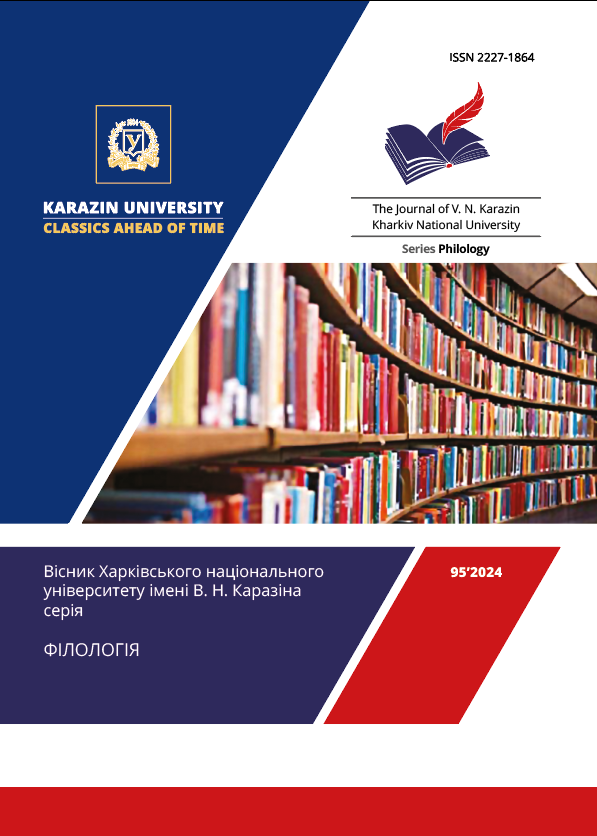Micro-field of Verbal Plurality in Latin
Abstract
The presented research deals with one of the components of the functional-semantic field of aspectuality namely the microfield of verbal plurality.
Despite the fact that verbal plurality is the subject of numerous studies, it has not been analyzed on the material of the Latin language, which determines the relevance of the study.
Within the framework of the aforementioned microfield, the analysis made it possible to single out the semantic zones of iterativity, multiplicativity, and distributivity. The presence of a certain number of similar acts separated by a time interval, the identity of actants and situations are characteristic features of iterativity with its subspecies refactivity, rarity and exaggerativity. Refactivity indicates a single repetition of a situation, realized at the word-forming level with the help of the prefix re- or the single use of the adverbs like rursum, iterum. Rarity and exaggerativity are scalar values, denoting situations whose frequency is lower or higher than expected.
Multiplicativity implies the repetition of the same type of situation with the same set of actants in one time interval without intervals between its “quanta”, as a result of which the situation is presented as continuous within the time interval. A type of multiplicativity is habituality to expres habitual situations, which are considered as a characteristic feature of the subject. Usitativity is distinguished as a subtype of habituality to characterize habitual situations existing under certain conditions.
Distributivity involves the performance of an action by one of a set of actants and, depending on the sphere of distribution of the situation. Its subspecies are subjective, objective, locative, subversive and cislocative distributivity.
The existence of certain semantic differences between iterativity, multiplicativity, and distributivity gives reason to consider them as subfields united within the microfield of verbal plurality by the sign of quantification. All of them are characterized by an identical set of markers, with lexical ones dominating. An extremely important role in the formation of verba plurality belongs to the context, which is decisive in the absence of formal means of expression.
Downloads
References
Allan, R. J. (2019). Aspect and Construal. A Cognitive Linguistic Approach to Iterativity, Habituality and Genericity in Greek. Towards a Cognitive Classical Linguistics. The Embodied Basis of Constructions in Greek and Latin. Berlin; Boston: De Gruyter, pp. 16-41 (DOI: https://doi.org/10.1515/9783110616347) [in English].
Berninetto, P. M., Lenci, A. (2010). Iterativity vs. habituality (and gnomic imperfectivity). Quaderni del laboratorio di linguistica. Vol.9,1, pp. 1-47 [in English].
Boneh, N., Doron, E. (2008). Habituality and the Habitual Aspect. Theoretical and Crosslinguistic Approaches to the Semantics of Aspect. Amsterdam: John Benjamins, pp. 321-347 (DOI: https://doi.org/10.1075/la.110.14bon) [in English].
Cohen, A. (2020). Iterativity. Something out of Nothing: The Semantics and Pragmatics of Implicit Quantification. Leiden: Brill. pp. 135-144 (DOI: https://doi.org/10.1163/9789004432598_007) [in English].
Comrie, B. (1976). Aspect. Cambridge: Cambridge University Press. IX, 142 p. [in English].
Cusic, D. (1981). Verbal plurality and aspect. Ph. D. dissertation. Stanford. 388 p. [in English].
Dahl, Ö. (1985). Tense and Aspect Systems. New York; Oxford: Basil Blackwell. VIII, 213 p. [in English].
Dressler, W. (1968). Studien zur verbalen Pluralität: Iterativum, Distributivum, Intensivum in der allgemeinen Grammatik, im Lateinischen und Hethitischen. Wien: Österreichische Akademie der Wissenschaften. 253 S. [in German].
Fortuin, E. (2023). Unbounded repetition, habituality, and aspect from a comparative perspective. Folia Linguistica. Vol. 57(1), pp. 135–175 (DOI: https://doi.org/10.1515/flin-2022-2054) [in English].
Haverling, G. V. M. (2010). Actionality, tense, and viewpoint. New Perspectives on Historical Latin Syntax.-Vol. 2: Constituent Syntax: Adverbial Phrases, Adverbs, Mood, Tense. Berlin; Boston: Walter de Gruyter, pp. 277–523. [in English].
Hofherr, P. C., Laca, B. (2012). Verbal Plurality and Distributivity. Berlin; Boston: De Gruyter, 2012. 233 p. (DOI: https://doi.org/10.1515/9783110293500) [in English].
Hofherr, P. C. (2021). Verbal plurality cross-linguistically. The Oxford Handbook of Grammatical Number. Oxford: Oxford University Press, pp. 307-341 [in English].
Hofmann, J. B., Szantyr , A. (1965). Lateinische Syntax und Stilistik. München: Beck. XCVIII, 935, 89 p. [in German].
Kühner, R., Stegmann, C. (1992). Ausführliche Grammatik der lateinischen Sprache. Dritter Teil: Satzlehre. Hannover: Hahnsche Buchhandlung. IX, 738 p. [in German].
La Roi, E. (2020). Habitual auxiliaries in Ancient Greek. Grammaticalization and diachronic collocation shifts. Indogermanische Forschungen. Bd. 125/1, pp. 135-163 (DOI: https://doi.org/10.1515/if-2020-008) [in English].
Pinkster, H. (2015). The Oxford Latin Syntax. Oxford: Oxford University Press. XXXII, 1430 p. [in English].
Rijkhoff, J. (1991). Nominal aspect. Journal of Semantics. Vol. 8. N 4, pp. 291–309. [in English].
Schwarzschild, R. (1996). Pluralities. Dordrecht: Kluwer Academic Publishers. IX, 211 p. [in English].




